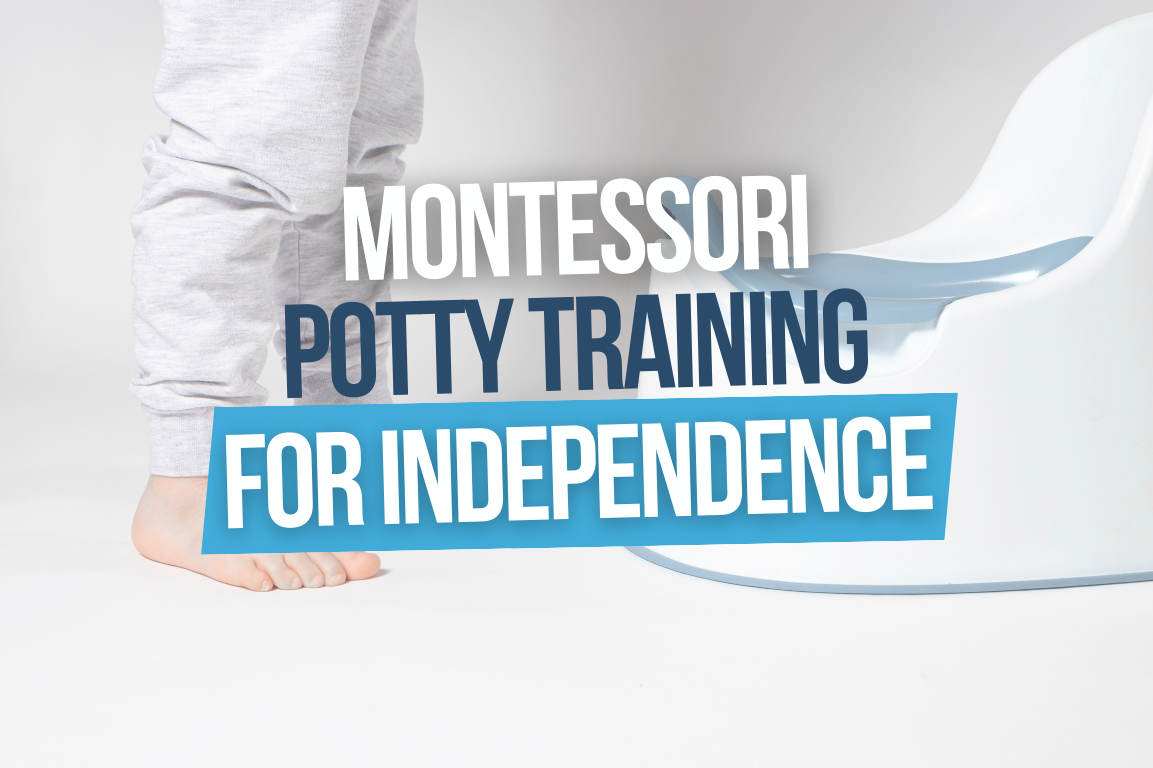Montessori Potty Training for Independence

Montessori potty training focuses on empowering children to learn toileting skills at their own pace. Instead of strict schedules or rewards, this approach emphasizes readiness signs, independence, and creating a child-friendly environment. By observing your child’s natural development and providing tools like child-sized potties and accessible supplies, you can support their journey toward mastering this essential skill. Here's a quick summary:
- Child-Led Approach: Encourages children to take the lead based on readiness cues like staying dry longer or showing interest in the toilet.
- Environment Setup: Use child-sized toilets, step stools, and accessible handwashing stations to promote self-sufficiency.
- Calm Guidance: Handle accidents without judgment and avoid pressure or rewards, focusing on encouraging natural habits.
- Daily Routines: Incorporate toileting into morning, meal, and bedtime routines, and teach self-cleanup for independence.
- Nighttime Support: Tools like PeelAways disposable sheets simplify cleanup for nighttime accidents.
This method not only teaches toileting but also builds confidence and responsibility, helping children develop lifelong skills.
Setting Up the Environment for Potty Training
Making the Bathroom Child-Friendly
Setting up a bathroom that works for your little one starts with seeing things from their perspective. Everything should be within their reach, making it easier for them to handle tasks on their own.
Start with a child-sized potty or a toilet insert paired with a sturdy step stool. It's important that your child’s feet can rest firmly on the ground or a footrest. This simple adjustment provides stability and supports the natural squatting position, which helps with elimination.
Keep toilet paper and wipes accessible by placing them on a low shelf. When kids can easily grab what they need, they’re more likely to take charge of their own bathroom routine. Add a small hand towel on a low hook and make sure soap is within arm’s reach of the sink.
Lighting also matters. Use a nightlight or keep the bathroom door slightly open during the day to ensure the space is well-lit. Many children feel more comfortable when they can clearly see their surroundings, especially during the early stages of potty training.
For clothing changes, set up a small stool or chair in the bathroom. This makes it easier for your child to sit down and change after an accident without needing to leave the room. Keeping everything contained in one space makes cleanup quicker and less stressful. This thoughtful setup creates a calm, child-focused environment that encourages independence.
Building a Calm and Supportive Space
Toileting can feel overwhelming for kids, so creating a peaceful bathroom space is key. Remove distractions like toys or books that might pull their focus away from paying attention to their body’s signals. A clutter-free environment helps them stay on task.
Keep the bathroom organized and simple. When everything has its place, children can learn to put items back where they belong, which builds independence and practical skills.
Pay attention to the emotional tone of the space. Stay calm during both successes and accidents. A neutral, matter-of-fact approach helps your child develop a positive and relaxed attitude toward potty training.
Don’t overlook comfort and temperature. A cold bathroom can make kids want to rush or avoid it altogether. If your bathroom tends to be chilly, consider adding a small space heater or adjusting the lighting to make the space feel warmer and more inviting.
Finally, make the bathroom a safe, unrushed space. When children feel pressured or hurried, they’re more likely to have accidents or develop anxiety about the process. A calm, supportive environment encourages them to learn at their own pace.
Tools for Managing Accidents
Accidents are part of the learning process, and having the right tools on hand can make cleanup smoother for everyone. The trick is to involve your child in the process without adding unnecessary stress.
PeelAways disposable waterproof bed sheets are a lifesaver during potty training. These sheets feature a multi-layer design with 5 to 7 absorbent layers, depending on the size. When an accident happens, you simply peel off the top layer to reveal a clean one underneath - no need for late-night mattress lifting or extra laundry loads. This is especially helpful for managing frequent nighttime accidents.
For toddler beds, the Crib-A-Peel option offers tailored protection with 5 layers designed specifically for smaller mattresses. The breathable fabric is soft on your child’s skin while providing waterproof coverage. This setup allows kids to confidently sleep in underwear instead of diapers, building their independence.
Keep a cleanup kit in the bathroom with essentials like paper towels, disinfectant wipes, and a small trash can. Letting your child help clean up teaches responsibility and natural consequences without shame. Just make sure the cleaning supplies are safe for kids to handle, or supervise closely.
Store extra clothes in the bathroom to make accidents less disruptive. A small basket with a couple of changes of underwear and pants ensures your child can quickly get dressed again and get back to their day.
For outings, consider using waterproof lap pads in car seats and strollers. These pads protect surfaces while giving your child the confidence to wear underwear outside the house. Maintaining consistency between home and public spaces helps reinforce their progress and reduces reliance on diapers when you’re on the go.
Spotting and Responding to Readiness Signs
Signs of Readiness in the Montessori Approach
The Montessori approach encourages observing your child’s unique development rather than adhering to strict timelines. Most children show signs of readiness for potty training between 18 months and 3 years old, but the pace varies for each child.
Physical readiness is often the first clue. For instance, your child might stay dry for longer stretches - 2 to 3 hours - or wake up from naps with a dry diaper. They should also be able to walk steadily and climb onto a potty or step stool without help. These motor skills indicate they’re physically prepared for bathroom independence.
Communication skills are another key factor. Your child should be able to follow simple instructions and express their needs, even if it’s just pointing or saying basic words like “potty” or “wet.” Some kids will let you know when their diaper is dirty or ask to be changed right away.
Pay attention to behavioral cues that show growing independence. Children often display readiness by wanting to dress themselves, mimic adult behaviors, or help with small tasks. They might follow you to the bathroom, show curiosity about the toilet, or express excitement about wearing “big kid” underwear.
Lastly, emotional readiness plays a big role. Your child should be in a stable phase without major disruptions like a new sibling, moving, or starting daycare. They should also be able to focus on tasks for a few minutes without being easily distracted.
These signs help you understand when your child is ready, setting the stage for a supportive and gentle approach to potty training.
Watching and Supporting Without Pressure
Once you notice readiness signs, your role is to provide gentle support, allowing your child to lead the process without feeling pressured.
Start by observing your child’s natural patterns. Pay attention to when they typically have bowel movements, how long they stay dry, and when they seem most aware of their body. Quietly noting these patterns helps you understand their rhythm without overwhelming them.
When readiness is evident, offer opportunities without expectations. For example, you might say, “I’m going to the bathroom. Do you want to come with me?” or, “Your potty is here if you’d like to use it.” The goal is to make the potty accessible without demanding results.
Avoid using rewards like stickers or treats. External motivators can take the focus away from developing internal awareness and self-control. Instead, acknowledge their efforts with simple statements like, “You sat on the potty,” or, “You told me you needed to go.”
Timing is everything. Offer potty opportunities during natural transitions, such as after meals, before baths, or when you notice signs like squirming or doing a “potty dance.” Avoid interrupting focused play or forcing bathroom breaks during activities they enjoy.
If your child resists or seems stressed, view it as useful feedback. Consistent refusal may mean they’re not ready yet. In that case, take a break for a few weeks and try again later. This isn’t a setback - it’s part of responsive parenting.
Managing Regressions and Setbacks
Even after successful potty training, accidents and setbacks are normal. Understanding these moments as part of the process helps you respond calmly and constructively.
Common triggers for regression include illness, stress, or significant changes in routine. A child who’s been dry for weeks might suddenly have multiple accidents. This doesn’t mean they’ve forgotten - it just means their attention is focused elsewhere.
When accidents happen, involve your child in the cleanup process without framing it as a punishment. This teaches natural consequences while preserving their dignity.
Nighttime dryness often takes longer to achieve than daytime control. It’s normal for children to stay dry during the day for months before consistently managing nighttime accidents. Using discreet protective tools can make this phase easier for everyone.
Try to avoid reverting to diapers once your child has transitioned to underwear unless it’s clear they’re not ready. Going back and forth can create confusion and slow progress. Instead, focus on providing extra support and maintaining consistency.
During challenging times, highlight successes rather than dwelling on setbacks. For example, if your child does well at home but struggles in public restrooms, celebrate their progress at home while patiently working on the areas that need improvement.
Above all, trust the process. Every child develops toilet independence at their own pace. Some master daytime control quickly but take longer for nighttime dryness, while others may need more time to develop emotional readiness despite having the physical skills. Avoid comparing your child’s journey to others - it only adds unnecessary pressure.
Your calm and steady approach reassures your child, helping them feel secure as they navigate this learning process. By maintaining a supportive and responsive environment, you’re setting them up for gradual, confident independence.
Building Daily Routines for Success
Adding Toileting to Daily Activities
Incorporating regular bathroom breaks into daily routines helps children establish natural habits. The trick is to seamlessly blend these moments into activities they already recognize and expect.
Morning routines are a great starting point. After your child wakes up, encourage a trip to the bathroom before getting dressed. This is especially important once they begin wearing underwear, as their bladder will likely be full from the night. Keep this moment calm and stress-free - it’s not a test.
Meal times, transitions, and sleep routines are natural opportunities for bathroom visits. For example, digestion often prompts the need to go 15-20 minutes after eating. Use transition moments, like leaving the house or returning home, as reminders. Similarly, include a bathroom stop before naps and bedtime as part of the wind-down process.
Pay attention to your child's individual patterns. Some kids need a bathroom break every two hours, while others can wait three to four hours. Once you notice their rhythm, offer bathroom opportunities just before they usually need to go.
Avoid disrupting focused play for routine potty breaks. If your child is deeply engaged in an activity, wait for a natural pause. Interrupting them can create resistance and negative feelings about bathroom visits.
Once toileting routines are consistent, the next step is teaching your child to handle cleanup independently.
Teaching Self-Sufficiency in Cleanup
Bathroom independence isn’t just about using the toilet - it’s about managing the entire process. Teaching kids to clean up after themselves builds confidence and responsibility, aligning with Montessori’s emphasis on child-led learning.
Start with the basics of using the toilet. Show your child how to pull down their pants, sit correctly, and wipe from front to back. Break these steps into smaller actions and practice when they’re calm, not in a rush.
Hand washing is an essential part of every bathroom visit. Set up a step stool so your child can reach the sink. Teach them to use soap, scrub for about 20 seconds (singing a short song can help), and dry their hands thoroughly. This routine encourages good hygiene while fostering independence.
Clothing management is another key skill. Choose easy-to-handle clothing - elastic waistbands are much simpler than buttons or belts. Practice dressing and undressing during relaxed times to build confidence.
When accidents happen, involve your child in the cleanup without making them feel ashamed. Guide them through changing into clean clothes, placing soiled items in the laundry, and wiping up any mess. This approach teaches natural consequences while maintaining their dignity.
For nighttime accidents, products like PeelAways disposable sheets make cleanup easier. Your child can peel away the soiled layer themselves, avoiding the hassle of changing bedding.
Make supplies accessible by storing extra underwear, wipes, and clean clothes in a low drawer or basket they can easily reach. This setup encourages self-reliance and reduces the need for constant assistance.
Avoiding Common Mistakes
Once routines and self-sufficiency are in place, it’s important to steer clear of common pitfalls that can hinder progress or create unnecessary stress during potty training.
Over-praising successes can unintentionally add pressure. Instead of big celebrations, use neutral affirmations like, "You used the potty." This keeps the focus on their own awareness rather than seeking approval.
Asking too often if they need to go can feel overwhelming. Constant questioning may make children feel under a microscope. Instead, offer bathroom opportunities at natural intervals without requiring a verbal response.
Rushing the process often backfires. External pressures from family, daycare, or deadlines can create anxiety for both you and your child. Trust that they’ll develop independence at their own pace.
Comparing progress with other children only adds unnecessary stress. Every child has their own timeline, so focus on their unique journey rather than external benchmarks.
Punishing accidents damages the learning process. Comments like "You should know better" or expressions of disappointment can make children afraid to share when accidents happen. Stay calm and supportive, regardless of the outcome.
Inconsistent approaches between caregivers can confuse children. If parents and other caregivers use different methods, the mixed messages can slow progress. Communicate with all caregivers to ensure consistency.
Forcing bathroom visits when a child resists often leads to power struggles. If they say no, respect their response and try again later. Forcing the issue can create negative associations with the potty.
Switching back to diapers during tough phases can disrupt progress. Once your child transitions to underwear, going back and forth can confuse expectations. Instead, provide extra support while staying consistent.
The Montessori approach encourages following your child’s lead while offering steady, gentle guidance. By avoiding these common mistakes, you create a supportive environment where your child can naturally and confidently develop toilet independence.
sbb-itb-45288fe
Building Long-Term Independence
Moving from Diapers to Underwear
Making the leap from diapers to underwear is a big step for both kids and parents. It’s a process that thrives on patience, timing, and following your child’s readiness - principles deeply rooted in the Montessori approach.
Wait for consistent daytime success before ditching diapers completely. Your child should regularly use the potty with minimal accidents over several weeks. Rushing this step can lead to frustration and setbacks for everyone.
Let your child pick out their own underwear. Whether they’re into dinosaurs, princesses, or bold patterns, letting them choose makes the switch to "big kid" underwear exciting rather than intimidating.
Start small. Begin with short periods of underwear use, like an hour or two at home, where you can keep a close eye and encourage frequent potty breaks. Gradually extend the time as your child gains confidence and has fewer accidents.
Be prepared for accidents - but avoid going back to diapers. Keep spare underwear and clothes handy in rooms your child uses most. When accidents happen, stay calm and involve your child in cleaning up. This helps them take ownership of the process.
Nighttime dryness takes longer. Even after daytime success, many kids need extra time to stay dry overnight. Use diapers or training pants at night until your child consistently wakes up dry for about a week.
Handle fears or resistance with care. Some children may feel anxious or overwhelmed by this new responsibility. Acknowledge their feelings, reassure them that learning takes time, and avoid forcing the transition if they seem distressed.
Once underwear becomes part of the routine, having the right tools can make the process smoother for both you and your child.
Using Tools to Support Child and Caregiver
The right tools can make this phase less stressful while encouraging your child’s independence.
PeelAways disposable sheets are a lifesaver for nighttime accidents. Their Crib-A-Peel option, priced at $30.99, comes with 5 waterproof layers. When an accident happens, you or your child can simply peel off the top layer, revealing a clean sheet underneath.
Keep supplies within easy reach. Place low baskets in the bathroom or bedroom with extra underwear, wipes, and comfy clothes. This setup empowers your child to handle small accidents on their own.
Step stools and toilet inserts help little ones feel secure using the bathroom. A sturdy, non-slip stool and a well-fitted toilet seat insert make adult-sized fixtures feel safer and more approachable.
Choose clothing that’s easy to manage. Elastic waistbands, dresses, and loose-fitting pants make it easier for kids to undress quickly. Steer clear of tricky buttons, belts, or tight clothing during this stage.
Pack a travel kit for outings. A small bag with extra underwear, wipes, plastic bags for soiled clothes, and a change of outfit ensures you’re prepared for accidents outside the home. This helps reduce stress for both you and your child.
With the right tools in place, your child can take on more responsibility with confidence.
Building Confidence and Responsibility
Mastering bathroom routines is about more than just using the potty - it’s an opportunity to build confidence and independence.
Involve your child in decisions. Let them pick their underwear, decide on outfits, or choose whether to use the bathroom before heading out. These small choices build autonomy and problem-solving skills, like handling a tricky toilet or asking for help in public restrooms.
Focus on the process with responsibility charts. Instead of tracking successful potty trips, highlight actions like washing hands or putting dirty clothes in the hamper. This approach reinforces habits that lead to independence without undue pressure.
Teach clear phrases for bathroom needs. Help your child practice saying things like “I need to use the bathroom” or “I had an accident and need help.” Clear communication boosts their confidence in various situations.
Acknowledge their efforts. Instead of rewards, use encouraging comments like, “You cleaned up all by yourself” or “Great job remembering to go potty before we left.” This reinforces their progress without creating external expectations.
Gradually step back as they gain confidence. Start by staying close during bathroom visits, then move to another room as they become more capable. This gradual shift helps them feel independent while knowing you’re still there if needed.
Treat setbacks as part of the process. If accidents increase or your child seems to regress, avoid jumping in to take over. Offer gentle reminders and a bit more support while still encouraging their independence.
Stress-Free Potty Training: The Montessori Approach To Potty Training (Step-by-Step Guide)
Conclusion
Montessori potty training embraces your child’s natural pace, creating a supportive environment that encourages true independence. By focusing on patience, thoughtful preparation, and empowerment, you allow your child to take the lead, build confidence, and develop skills that will serve them for a lifetime.
Turning these principles into daily habits requires practical steps and consistent support. Setting up a child-friendly bathroom, providing easy-to-reach supplies, and choosing clothing they can manage on their own are all key to making the process smoother. These small adjustments make a big difference, turning potential stress into opportunities for growth. And yes, accidents will happen - but how you respond is what truly matters.
For example, tools like PeelAways disposable sheets simplify cleanup during nighttime accidents. Their Crib-A-Peel option offers multi-layer protection, making transitions at night much easier [1].
Setbacks are a natural part of learning and don’t signal failure. When accidents occur or progress stalls, these moments are valuable opportunities to nurture problem-solving skills and resilience. The Montessori philosophy reminds us that children are inherently capable - they just need the right environment, tools, and encouragement to show us what they can achieve.
FAQs
How do I know if my child is ready for Montessori potty training, and what signs should I look for?
When your child begins to show curiosity about the bathroom - like watching or imitating your habits - it might be time to consider Montessori potty training. Other signs to look for include walking on their own, staying dry for longer periods, and showing discomfort with dirty diapers. While these milestones often appear between 12 and 24 months, remember that every child develops at their own pace.
Instead of rushing, focus on your child's readiness cues. Creating a supportive, child-friendly bathroom setup can make the process easier and encourage their independence. To help manage the inevitable messes during this stage, products like Peelaways disposable, waterproof bed sheets can be a lifesaver, simplifying cleanup and letting you concentrate on your child’s progress.
What are common challenges in Montessori potty training, and how can parents overcome them?
Parents often encounter hurdles like a child resisting the process, trouble establishing consistent routines, or the child not taking the initiative to use the toilet independently. Tackling these issues involves respecting your child’s natural readiness, maintaining a calm, pressure-free atmosphere, and encouraging independence without pushing too hard.
By focusing on your child’s individual readiness and letting them explore toileting at their own pace, you can help build their confidence. Simple tools like easy-to-remove clothing or waterproof options such as Peelaways disposable bed sheets can make the journey smoother. These practical solutions help minimize stress around accidents, keeping both you and your child more at ease and motivated.
How can I set up a bathroom that helps my child feel confident and independent during potty training?
Creating a bathroom setup that supports your child’s independence during potty training involves focusing on safety, accessibility, and a welcoming environment. Start by using a small potty or a sturdy step stool to help them reach the toilet with ease. Place essentials like toilet paper, wipes, and soap within arm’s reach to encourage their self-sufficiency.
Incorporate calming elements such as soft lighting, non-slip mats, and neatly organized storage for bathroom necessities. These simple changes can make the space feel inviting and help your little one feel more at ease and confident as they navigate this new skill. For those inevitable accidents, Peelaways disposable, waterproof bed sheets are a game-changer. Their peel-away design makes cleanup quick and hassle-free, making this stage a bit easier for everyone.
Related Blog Posts
- Quick Guide: Managing Overnight Accidents in Children
- Ultimate Guide To Potty Training Routines
- Best Certification Programs for Incontinence Care Training
- Ultimate Guide to Bedwetting Routines
Comments
0

SAVE MONEY & WATER
Professionals & Institutions save a fortune on labor/laundry.

SUPERIOR COMFORT
The first thing our customers notice is how soft our sheets are.

100% WATERPROOF
Each layer is 100% Waterproof, perfect for spills and accidents

SAVE TIME
Change the sheet in under 1 minute without stripping the bed.




Leave a comment